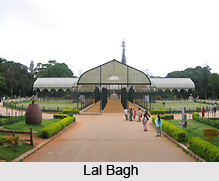 The Lal Bagh Botanical Garden is a famous Botanical Garden of India situated at Bangalore. The ruler of Mysore, Hyder Ali, established the garden.
The Lal Bagh Botanical Garden is a famous Botanical Garden of India situated at Bangalore. The ruler of Mysore, Hyder Ali, established the garden.
Hyder Ali started building the Garden of Lal Bagh in the year 1760 and his son Tipu Sultan completed the garden. Lal Bagh spans over an extensive area of two hundred and forty acres or 9,71,000 square meter or almost 1 square kilometer. The garden is situated on the southern side of the city of Bangalore. The Lal Bagh garden arranges numerous flower shows over the year, among which the flower show at the ceremony of the Republic Day (26th January) is most renowned. The garden contains over a thousand of species of flora. Another center of attraction of the Garden is the Glass House following the model of Crystal Palace of London. Now this Glass House is remodeled with a different layout. Hyder Ali planned the design of this famous garden and his son Tipu Sultan increased the wealth of this garden by importing several trees and plants from various foreign countries. The Garden of Lal Bagh was established on the eighteenth century and over the years it had the first lawn-clock of India and the largest collection of rare plants in the subcontinent. There are trees in the garden, which are over century old.
In the center of the Lal Bagh Garden, there is a tower erected by the founder of the Bangalore, Kempe Gowda. Hyder Ali planned to create this garden following the style of Mughal Gardens that were very popular at the contemporary time. There are some rare species of flora in the park, which were brought from Persia, Afghanistan and France. The Lal Bagh garden is tastefully designed with intricate system of irrigation, lawns, flowerbeds, lotus pools and beautiful fountains. The trees, which are aged more than hundred years, are labeled for easy identifications. The other attraction of the park that draw the attention of the crowd is the Lalbagh Rock, one of the oldest rock formation on Earth, about three thousand million years old.
The design of the Lal Bagh Garden follows the Mughal gardens, specially that stands at Sira, 120 kilometers away from Bangalore beside the national highway 4 at Tumkur district of Karnataka. Archeological Survey of India and other historical records support the fact. At that time Sira was the capital or headquarter of Mughals southern part of `Suba` in the Deccan India.
Lal Bagh Garden remains open daily from 6.00 am to 9 pm all around the year. There is no entry charge from 6 am to 9 am and 6pm to 7pm for the benefits of fitness freaks and joggers. During the other time of the day a fee of rupees ten is charged from the tourists. The school children and the disabled require no entry charge throughout the day.
Flower shows are conducted every year to make people aware of different flora and also grow the habit in them to cultivate plants. The Government of Karnataka organizes Janapada Jaatre in the park of LalBagh on the second and fourth Saturday and Sunday of every month. Janapada Jaatre is a kind of folk fare that includes folk dance, music and plays performed by the troops all over the Karnataka state. The shows mainly depict the cultural folklore of Karnataka, their traditional costumes and musical links.
LalBagh is currently under the aegis of the Directorate of Horticulture, Government of Karnataka. The Directorate is located amidst the beautiful environment of the Botanical garden. LalBagh was given the status of a Government Botanical Garden in the year 1856 and since then it has been a place of internationally famous center for the scientific study of flora and also researches for the conservation of plants. The landscape of the garden perfectly blends formal and informal styles and has the testimony of natural and artificial beauty. The garden is a lush green paradise situated at the heart of the city of Bangalore.



















